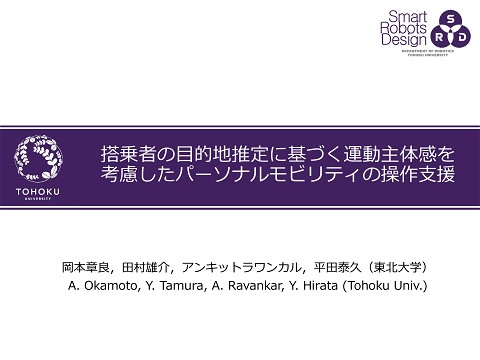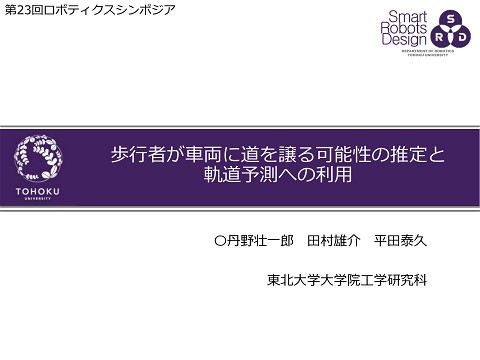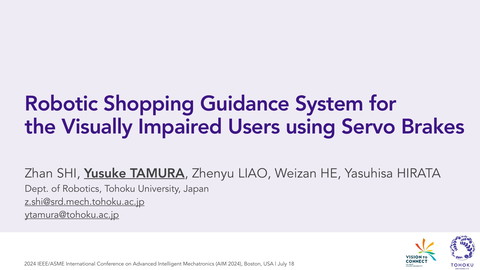Shared Control Support System for Electric Wheelchair Based on Intended Gap (SICE FES 2025)
174 Views
September 13, 25
スライド概要
Le Van Tan, Yusuke Tamura, Yasuhisa Hirata, "Shared Control Support System for Electric Wheelchair Based on Intended Gap," Proceedings of the 2025 SICE Festival with Annual Conference, pp.189-194, 2025.
東北大学大学院工学研究科ロボティクス専攻 田村研究室
関連スライド
各ページのテキスト
Smart Robots Design DEPARTMENT OF ROBOTICS TOHOKU UNIVERSITY Shared Control Support System for Electric Wheelchair Based on Intended Gap Le Van Tan, Yusuke Tamura, Yasuhisa Hirata Tamura Laboratory Graduate School of Engineering, Department of Robotics, Tohoku University
OUTLINE ◆ Research Background ◆ Related research ◆ Research goal ◆ Proposed method ◆ Experiment ◆ Result and Discussion ◆ Conclusion and Future work 2025/9/13 Smart Robots Design Lab. 1
Research Background Demand for wheelchair is increasing Approximately 131,800,000 people (1.85% world population) in the world in need of a wheelchair. Population increasing by 187,500 each day => there is a increase need for 3,500 wheelchairs every day In developing countries, 121,800,000 people require a wheelchair and less than 10% of them have access to one => Unmet demand + population growth : Number of wheelchair user will increase in the future Source: Wheelchair Foundation 2025/9/13 Smart Robots Design Lab. 2
Research Background Controlling electric wheelchair can be difficult - Disabilities that hinder wheelchair operation with joystick controller: - Fine motor impairment - Cognitive impairment - Visual impairment - These disabilities are not severe enough to need a special control method (other than joystick) Need to have a system that make controlling wheelchair easier and safer for these group of people 2025/9/13 Smart Robots Design Lab. 3
Related Research | Obstacle avoidance shared Modify existing obstacle avoidance algorithm for shared contro l control Obstacle avoidance based on Velocity Obstacle Modified Vector Field Histogram for obstacle avoidance Support in crowd navigation Sona sensor for obstacle detection NavChair[2] Pros: - Provide obstacle avoidance functionality - Retain user control authority. User feels independent. Qolo [3] Cons: - Do not provide navigation support Eg: Difficult to pass through small gap (door, gateway) (algorithm limitation) [2]Levine, S. P., Bell, D. A., Jaros, L. A., & Simpson, R. C. (1999). The NavChair assistive wheelchair navigation system. IEEE Transactions on Rehabilitation Engineering, 7(4), 443-453. [3] Qolo: D. J. Gonon, D. Paez-Granados and A. Billard, "Reactive Navigation in Crowds for Non-Holonomic Robots With Convex Bounding Shape," in IEEE Robotics and Automation Letters, vol. 6, no. 3, pp. 4728-4735, July 2021. 2025/9/13 Smart Robots Design Lab. 4
Related Research | Navigation support with intention estimation Predict navigation intention and provide appropriate support Pro: - Provide navigation support based on user intention Cons: - No clear indication of reducing user effort - Rely on global map for intention prediction, limiting operation domain of the system [4] Door intention prediction [5] Path intention prediction [4] Carlson, T., & Demiris, Y. Human-wheelchair collaboration through prediction of intention and adaptive assistance. In 2008 IEEE International Conference on Robotics and Automation, 2008. [5] Z. Lei, B. Y. Tan, N. P. Garg, L. Li, A. Sidarta and W. T. Ang, "An Intention Prediction Based Shared Control System for Point-to-Point Navigation of a Robotic Wheelchair," in IEEE Robotics and Automation Letters, vol. 7, no. 4, Oct. 2022 2025/9/13 Smart Robots Design Lab. 5
Research goal Develop a shared control support system based on intention estimation Help user control wheelchair in difficult situation such as small, tight space 2025/9/13 Retaining sense of control for user Smart Robots Design Lab. Applicable in unknown environment (no need for map and goal) 6
Proposed method | Overview Navigation intention estimation: ~0.1s per loop ● Local gap detection: detect set of passible gaps as candidate goals ● Intended gap estimation: predict intended gap that user want to navigate to Shared control: MPPI controller: combining intended gap, user’s input, scan data to control the wheelchair System overview 2025/9/13 Smart Robots Design Lab. 7
Proposed method | Local gap detection ? ? • • • Human tends to find “passable space” to pass through to reach a goal. Find “passible space” as “gap” from 2D scan Use “gap” as navigation intention candidates to eliminate the need for map 2025/9/13 Local goals Smart Robots Design Lab. 8
Proposed method | Intended gap estimation Cost function: Local goal Alignment Favor wheelchair-goal alignment Cost function variable Weight change for theta and theta_g Calculate optimal trajectory that minimize cumulative cost Compare to past trajectory Predict intended goal 2025/9/13 Example of optimal path Smart Robots Design Lab. How intended goal is selected 9
Proposed method | MPPI controller Definition: Optimization-based control method Use Monte Carlo sampling to find the optimal control actions by predicting future states over a finite horizon User cost function: Cost function punishes output that differ from user’s input => Achieve shared control 2025/9/13 Smart Robots Design Lab. MPPI controller principle 10
Proposed method | MPPI controller Goal cost function: Make path to intended goal with A* PathAlignCritics: Minimize the differences between A* path and output path Lidar obstacle cost function: Add VERY HIGH COST to sampled path with collision Ensure collision-free for final output path Travelled distance along path 2025/9/13 Smart Robots Design Lab. 11
Experiment | Overview Purpose: Validate system’s effectiveness in 2 scenarios (daily life and going through small gap) Study how user feel using the proposed system via a questionnaire Hardware system: WHILL CR2 2x 2D Lidar Hokuyo UST20-LX. PC to run the system Participant: 7 healthy adults without prior experience in controlling ewheelchair Wear special glass to simulate visual impairment 2025/9/13 Smart Robots Design Lab. 12
Experiment 1 | Daily life scenario Purpose: Procedure: Evaluate the performance of the system and user feeling in everyday life scenario when user are aware and not aware of the system Task: Follow a predefined path in an environment representing a normal house (Living Lab) End Start 2025/9/13 Smart Robots Design Lab. 13
Experiment 2 | Gap Purpose: Evaluate the performance of the system and user feeling when performing a difficult task of going through small gap Task: Pass through a small gap Width of gap = 0.7m Width of wheelchair = 0.6m 0.1m clearance Procedure: Perform task with and without proposed system in random order Participant are aware of the system’s usage to fully take advantage of the system 2025/9/13 Smart Robots Design Lab. 14
Experiment | Questionnaire Content of questionnaire: 1) Rate the difficulty of the task from 1-10. 1 is Easy and 10 is Difficult 2) Rate how do you feel you were able to control the wheelchair from 1-10. 1 is Cannot Control and 10 is Complete Control Purpose: Subjective view of how user feel using the system Conduct: Participant are asked to answer the questionnaire every time they complete a run in both experiment 2025/9/13 Smart Robots Design Lab. 15
Result and Discussion | Overview Subjective result: - Measurement of controllability and perceived difficulty: Based on questionnaire result Objective result: - Measurement of control effort: Percentage of joystick signal changed in each run. Smaller => Less effort 2s. Std > 0.02 Plot of input joystick signal w.r.t time for one run 2025/9/13 Smart Robots Design Lab. 16
Result and Discussion | Measurement of control effort Control effort score: Percentage of joystick signal change in the whole run In both experiment, most users has less joystick signal change with the system=>Reduced control effort When users are aware of the system, the reduction in control effort is more evident. 2025/9/13 Smart Robots Design Lab. 17
Result and Discussion | Subjective Measurement score: Perceived difficulty and controllability Average difficulty and controllability score for 7 participants in 2 experiment Discussion: The proposed system make user feel less difficult when go through a small gap. When user knows about the system, they perceive less difficulty performing the task There are some negative impact on controllability, albeit not by a large margin. 2025/9/13 Smart Robots Design Lab. 18
Conclusion and Future work Conclusion In this research, a shared control support system for electric wheelchair based on local gap intention estimation was developed The system can reduce user’s controlling effort, making user feel easier in controlling wheelchair, especially through small gap Future works Quantify and improve the accuracy of intention estimation method Eliminate the need for local goal for each gap Enhancing controllability by better shared control scheme 2025/9/13 Smart Robots Design Lab. 19





